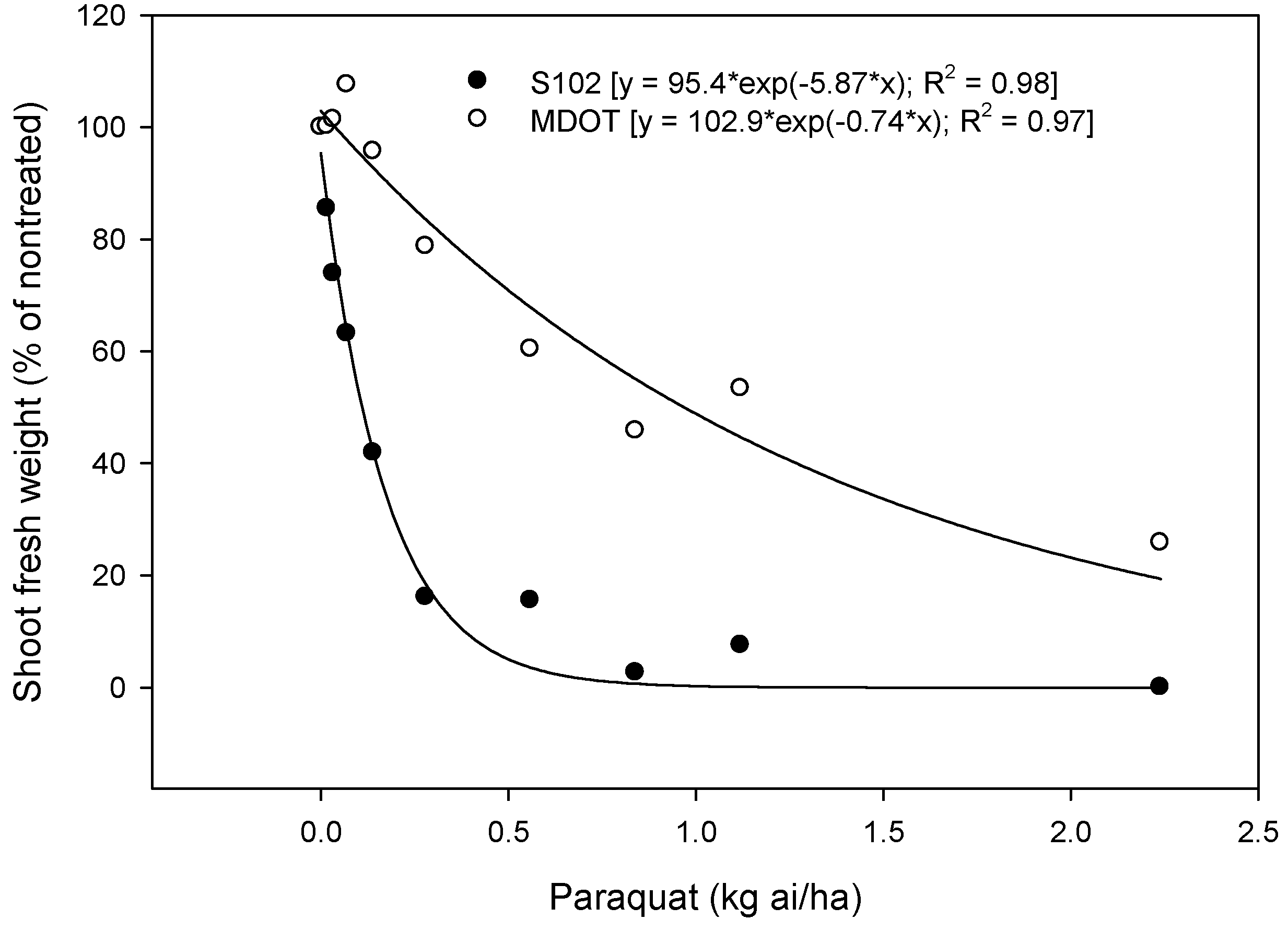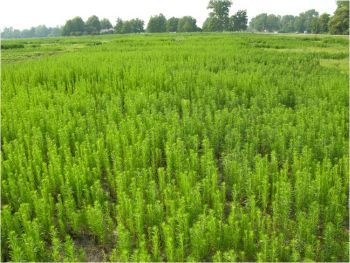Multiple Resistance of Horseweed to Glyphosate and Paraquat and Its Control with Paraquat and Metribuzin Combinations
Abstract
:1. Introduction
2. Results and Discussion
2.1. Glyphosate and Paraquat Multiple Resistance Estimation


2.2. Paraquat and Metribuzin Influence on Horseweed Growth and Soybean Yield
| 2007 | 2008 | ||||||||
|---|---|---|---|---|---|---|---|---|---|
| Rate | Control | Density | Biomass | Yield | Control | Density | Biomass | Yield | |
| Treatment | kg ai/ha | 28 DAT | 28 DAT | 28 DAT | kg/ha | 28 DAT | 28 DAT | 28 DAT | kg/ha |
| ____%___ | plants/m2 | g/m2 | ____%___ | plants/m2 | g/m2 | ||||
| Nontreated | 0 | 48 | 360 | 360 | 0 | 30 | 110 | 740 | |
| Paraquat b | 0.56 | 72 | 73 | 150 | 540 | 30 | 65 | 360 | 1200 |
| Paraquat | 0.84 | 80 | 38 | 90 | 360 | 40 | 71 | 430 | 1250 |
| Paraquat | 1.12 | 88 | 23 | 40 | 740 | 50 | 59 | 470 | 1370 |
| Paraquat + Metribuzin | 0.56 + 0.1 | 93 | 6 | 10 | 1220 | 40 | 89 | 290 | 1340 |
| Paraquat + Metribuzin | 0.56 + 0.2 | 93 | 5 | 10 | 1490 | 48 | 37 | 180 | 1570 |
| Paraquat + Metribuzin | 0.56 + 0.4 | 98 | 2 | 5 | 1490 | 50 | 47 | 290 | 1400 |
| Paraquat + Metribuzin | 0.84 + 0.1 | 93 | 4 | 10 | 1290 | 48 | 35 | 270 | 1310 |
| Paraquat + Metribuzin | 0.84 + 0.2 | 100 | 1 | 0 | 1900 | 53 | 25 | 200 | 1520 |
| Paraquat + Metribuzin | 0.84 + 0.4 | 100 | 0 | 0 | 1990 | 78 | 16 | 140 | 1440 |
| Paraquat + Metribuzin | 1.12 + 0.1 | 95 | 1 | 5 | 1870 | 73 | 16 | 50 | 1360 |
| Paraquat + Metribuzin | 1.12 + 0.2 | 98 | 0 | 1 | 2060 | 78 | 13 | 90 | 1300 |
| Paraquat + Metribuzin | 1.12 + 0.4 | 100 | 0 | 0 | 1680 | 83 | 3 | 10 | 1250 |
| LSD (0.05) | 7 | 27 | 105 | 650 | 18 | 45 | 240 | 720 | |
| a Abbreviations: DAT, days after treatment; NIS, nonionic surfactant; b All paraquat treatments included NIS at 0.5% v/v. | |||||||||
| 2007 | 2008 | ||||||||
|---|---|---|---|---|---|---|---|---|---|
| Control | Density | Biomass | Control | Density | Biomass | ||||
| Treatment | Rate | 28 DAT | 28 DAT | 28 DAT | Yield | 28 DAT | 28 DAT | 28 DAT | Yield |
| kg ai/ha | ____%___ | plants/m2 | g/m2 | kg/ha | ____%___ | plants/m2 | g/m2 | kg/ha | |
| Nontreated | 0 | 44 | 1260 | 160 | 0 | 59 | 450 | 1140 | |
| Paraquat b | 0.56 | 60 | 23 | 110 | 1230 | 53 | 46 | 420 | 1520 |
| Paraquat | 0.84 | 73 | 17 | 130 | 990 | 70 | 35 | 240 | 1580 |
| Paraquat | 1.12 | 90 | 9 | 70 | 1860 | 70 | 37 | 240 | 1410 |
| Paraquat + Metribuzin | 0.56 + 0.1 | 85 | 16 | 50 | 1680 | 78 | 19 | 80 | 1560 |
| Paraquat + Metribuzin | 0.56 + 0.2 | 93 | 3 | 10 | 1960 | 85 | 10 | 80 | 1620 |
| Paraquat + Metribuzin | 0.56 + 0.4 | 88 | 17 | 80 | 1710 | 80 | 24 | 150 | 1610 |
| Paraquat + Metribuzin | 0.84 + 0.1 | 90 | 8 | 30 | 2240 | 93 | 14 | 110 | 1470 |
| Paraquat + Metribuzin | 0.84 + 0.2 | 95 | 4 | 10 | 2270 | 95 | 7 | 120 | 1610 |
| Paraquat + Metribuzin | 0.84 + 0.4 | 100 | 0 | 0 | 2340 | 95 | 2 | 10 | 1580 |
| Paraquat + Metribuzin | 1.12 + 0.1 | 98 | 1 | 30 | 2410 | 95 | 8 | 50 | 1550 |
| Paraquat + Metribuzin | 1.12 + 0.2 | 100 | 0 | 0 | 2460 | 98 | 6 | 80 | 1630 |
| Paraquat + Metribuzin | 1.12 + 0.4 | 98 | 5 | 10 | 1940 | 98 | 1 | 10 | 1750 |
| LSD (0.05) | 9 | 21 | 240 | 660 | 14 | 32 | 240 | 720 | |
| a Abbreviations: DAT, days after treatment; NIS, nonionic surfactant; b All paraquat treatments included NIS at 0.5% v/v. | |||||||||
3. Experimental Section
3.1. Multiple Resistance Study
3.2. Paraquat and Metribuzin Study
4. Conclusions
References
- Senseman, S.A. Herbicide Handbook, 9th ed; Weed Science Society of America: Lawrence, KS, USA, 2009. [Google Scholar]
- Devine, M.D.; Duke, S.O.; Fedtke, C. Other herbicidal interactions with photosynthesis. In Physiology of Herbicide Action; Prentice Hall: Englewood Cliffs, NJ, USA, 1993; pp. 141–166. [Google Scholar]
- Eubank, T.W.; Poston, D.H.; Nandula, V.K.; Koger, C.H.; Shaw, D.R.; Reynolds, D.B. Glyphosate-resistant horseweed (Conyza canadensis) control using glyphosate-, paraquat-, and glufosinate-based herbicide programs. Weed Technol. 2008, 22, 16–21. [Google Scholar] [CrossRef]
- Heap, I. Herbicide Resistant Weeds. Weed Science Society of America. Available online: http://www.weedscience.org/ (accessed on 1 November 2012).
- Kato, A.; Okuda, Y. Paraquat resistance in Erigeron canadensis. Weed Res. 1983, 28, 54–56. [Google Scholar]
- Watanabe, Y.; Honma, T.; Ito, K.; Miyrahara, M. Paraquat resistance in Erigeron philadelphicus L. Weed Res. 1982, 27, 49–54. [Google Scholar]
- Smisek, A.; Doucet, C.; Jones, M.; Weaver, S. Paraquat resistance in horseweed (Conyza canadensis) and Virginia pepperweed (Lepidium virginicum) from Essex County, Ontario. Weed Sci. 1998, 46, 200–204. [Google Scholar]
- Weaver, S.; Downs, M.; Neufeld, B. Response of paraquat-resistant and -susceptible horseweed (Conyza canadensis) to diquat, linuron, and oxyfluorfen. Weed Sci. 2004, 52, 549–553. [Google Scholar] [CrossRef]
- VanGessel, M.J.; Scott, B.A.; Johnson, Q.R. Paraquat-resistant horseweed identified in the Mid-Atlantic States. Crop Manag. 2006. doi:1094/cm-2006-0420-01-RS . [Google Scholar]
- Fuerst, E.P.; Nakatani, H.Y.; Dodge, A.D.; Penner, D.; Arntzen, C.J. Paraquat resistance in Conyza. Plant Physiol. 1985, 77, 984–989. [Google Scholar] [CrossRef]
- Jori, B.; Soos, V.; Szego, D.; Paldi, E.; Szigeti, Z.; Racz, I.; Lasztity, D. Role of transporters in paraquat resistance of horseweed Conyza canadensis (L.) Cronq. Pestic. Biochem. Physiol. 2007, 88, 57–65. [Google Scholar]
- Norman, M.A.; Fuerst, E.P.; Smeda, R.J.; Vaughn, K.C. Evaluation of paraquat resistance mechanisms of Conyza. Pestic. Biochem. Physiol. 1993, 46, 236–249. [Google Scholar] [CrossRef]
- VanGessel, M.J. Glyphosate-resistant horseweed from Delaware. Weed Sci. 2001, 49, 703–705. [Google Scholar] [CrossRef]
- Koger, C.H.; Poston, D.H.; Hayes, R.M.; Montgomery, R.F. Glyphosate-resistant horseweed (Conyza canadensis) in Mississippi. Weed Technol. 2004, 18, 820–825. [Google Scholar] [CrossRef]
- Ge, X.; d’Avignon, D.A.; Ackerman, J.J.; Sammons, R.D. Rapid vacuolar sequestration: The horseweed glyphosate resistance mechanism. Pest Manag. Sci. 2010. [Google Scholar] [CrossRef]
- Feng, P.C.; Tran, M.; Chiu, T.; Sammons, R.D.; Heck, G.R.; CaJacob, C.A. Investigation into glyphosate-resistant horseweed (Conyza canadensis): Retention, uptake, translocation, and metabolism. Weed Sci. 2004, 52, 498–505. [Google Scholar] [CrossRef]
- Koger, C.H.; Reddy, K.N. Role of absorption and translocation in the mechanism of glyphosate resistance in horseweed (Conyza canadensis). Weed Sci. 2005, 53, 84–89. [Google Scholar] [CrossRef]
- Yu, Q.; Cairns, A.; Powles, S.B. Glyphosate, paraquat and ACCase multiple herbicide resistance evolved in a Lolium rigidum biotype. Planta 2007, 225, 499–513. [Google Scholar]
- Owen, L.N.; Steckel, L.E.; Koger, C.H.; Main, C.L.; Mueller, T.C. Evaluation of spring and fall burndown application timings on control of glyphosate-resistant horseweed (Conyza canadensis) in no-till cotton. Weed Technol. 2009, 23, 335–339. [Google Scholar] [CrossRef]
- Steckel, L.E.; Craig, C.C.; Hayes, R.M. Glyphosate-resistant horseweed (Conyza canadensis) control with glufosinate prior to planting no-till cotton (Gossypium hirsutum). Weed Technol. 2006, 20, 1047–1051. [Google Scholar] [CrossRef]
- Steckel, L.E.; Gwathmey, C.O. Glyphosate-resistant horseweed (Conyza canadensis) growth, seed production, and interference in cotton. Weed Sci. 2009, 57, 346–350. [Google Scholar] [CrossRef]
- Purba, E.; Preston, C.; Powles, S.B. The mechanism of resistance to paraquat is strongly temperature dependent in resistant Hordeum leporinum Link. and H. glaucum Steud. Planta 1995, 196, 464–468. [Google Scholar]
- Kumaratilake, A.R.; Preston, C. Low temperature reduces glufosinate activity and translocation in wild radish (Raphanus raphanistrum). Weed Sci. 2005, 53, 10–16. [Google Scholar] [CrossRef]
- Putnam, A.R.; Ries, S.K. The synergistic action of herbicide combinations containing paraquat on Agropyron repens (L.) Beauv. Weed Res. 1967, 7, 191–199. [Google Scholar]
- Colby, S.R.; Wojtazek, T.; Warren, G.F. Synergistic and antagonistic combinations for broadening herbicidal selectivity. Weeds 1965, 13, 87–91. [Google Scholar] [CrossRef]
- Griffin, J.L.; Miller, D.K.; Ellis, J.M.; and Clay, P.A. Sugarcane tolerance and Italian ryegrass (Lolium multiflorum) control with paraquat. Weed Technol. 2004, 18, 555–559. [Google Scholar] [CrossRef]
- Kapusta, G. Seedbed tillage and herbicide influence on soybean (Glycine max) weed control and yield. Weed Sci. 1979, 27, 520–526. [Google Scholar]
© 2012 by the authors; licensee MDPI, Basel, Switzerland. This article is an open-access article distributed under the terms and conditions of the Creative Commons Attribution license (http://creativecommons.org/licenses/by/3.0/).
Share and Cite
Eubank, T.W.; Nandula, V.K.; Poston, D.H.; Shaw, D.R. Multiple Resistance of Horseweed to Glyphosate and Paraquat and Its Control with Paraquat and Metribuzin Combinations. Agronomy 2012, 2, 358-370. https://doi.org/10.3390/agronomy2040358
Eubank TW, Nandula VK, Poston DH, Shaw DR. Multiple Resistance of Horseweed to Glyphosate and Paraquat and Its Control with Paraquat and Metribuzin Combinations. Agronomy. 2012; 2(4):358-370. https://doi.org/10.3390/agronomy2040358
Chicago/Turabian StyleEubank, Thomas W., Vijay K. Nandula, Daniel H. Poston, and David R. Shaw. 2012. "Multiple Resistance of Horseweed to Glyphosate and Paraquat and Its Control with Paraquat and Metribuzin Combinations" Agronomy 2, no. 4: 358-370. https://doi.org/10.3390/agronomy2040358
APA StyleEubank, T. W., Nandula, V. K., Poston, D. H., & Shaw, D. R. (2012). Multiple Resistance of Horseweed to Glyphosate and Paraquat and Its Control with Paraquat and Metribuzin Combinations. Agronomy, 2(4), 358-370. https://doi.org/10.3390/agronomy2040358





